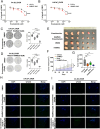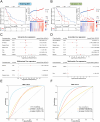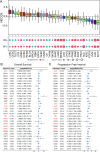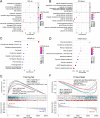GG-NER's role in androgen receptor signaling inhibitor response for advanced prostate cancer
- PMID: 39696559
- PMCID: PMC11658306
- DOI: 10.1186/s12964-024-01977-0
GG-NER's role in androgen receptor signaling inhibitor response for advanced prostate cancer
Abstract
Background: Advanced prostate cancer (PCa) often initially responds to androgen receptor signaling inhibitors (ARSI) but frequently develops resistance, driven by tumor heterogeneity and therapeutic pressure. Addressing the clinical challenge of identifying non-responsive patients and discovering new therapeutic targets is urgently needed.
Methods: We utilized single-sample gene set enrichment analysis (ssGSEA) to elucidate the influence of the GG-NER pathway on ARSI response in PCa. We then constructed and validated a prognostic model based on this pathway using LASSO regression, Kaplan-Meier analysis, Cox regression, and ROC analysis. Additionally, we mapped tumor mutations to delineate the mutational landscapes across different risk groups and explored functional pathways through GO, KEGG, and GSEA analyses. The impact of the GG-NER pathway on enzalutamide sensitivity and DNA repair in PCa was further validated through CCK-8 assays, colony formation assays, in vivo experiments, and immunofluorescence.
Results: ssGSEA indicated a trend of GG-NER pathway upregulation in patients with poor ARSI response. The GG-NER characteristic gene score (NECGS) identified a high-risk group with diminished ARSI response, serving as an independent prognostic indicator with strong predictive power. This high-risk group exhibited elevated TP53 mutation frequencies and significant enrichment in key pathways such as ribosome and mitochondrial functions, as well as MYC and E2F signaling. Experimental validation confirmed that targeting the GG-NER pathway or its key gene, ACTL6A, significantly reduces enzalutamide resistance in resistant cell lines and increases γH2AX expression.
Conclusion: NECGS effectively predicts ARSI response in PCa, and our comprehensive analysis underscores the critical role of the GG-NER pathway in enzalutamide resistance, positioning ACTL6A as a potential therapeutic target for PCa.
Keywords: ACTL6A; ARSI; Enzalutamide; GG-NER; Prostate cancer.
© 2024. The Author(s).
Conflict of interest statement
Declarations. Ethics approval and consent to participate: All the transcriptome data of PCa patients was acquired from open-sourced platforms including TCGA, cBioPortal, GDC Portal and UCSC websites, and the voluntarily informed consent for patients was not available. The current study was approved by the Ethics Committee of Zhujiang Hospital, Southern Medical University. Competing interests: The authors declare no competing interests. Competing of interest: The authors declare that they do not have any conflicts of interest.
Figures








References
-
- Sung H, Ferlay J, Siegel RL, Laversanne M, Soerjomataram I, Jemal A, Bray F. Global Cancer statistics 2020: GLOBOCAN estimates of incidence and Mortality Worldwide for 36 cancers in 185 countries. CA Cancer J Clin. 2021;71(3):209–49. - PubMed
-
- Rebello RJ, Oing C, Knudsen KE, Loeb S, Johnson DC, Reiter RE, Gillessen S, Van der Kwast T, Bristow RG. Prostate cancer. Nat Rev Dis Primers. 2021;7(1):9. - PubMed
-
- Cornford P, van den Bergh RCN, Briers E, Van den Broeck T, Cumberbatch MG, De Santis M, Fanti S, Fossati N, Gandaglia G, Gillessen S, Grivas N, Grummet J, Henry AM, der Kwast THV, Lam TB, Lardas M, Liew M, Mason MD, Moris L, Oprea-Lager DE, der Poel HGV, Rouvière O, Schoots IG, Tilki D, Wiegel T, Willemse PM, Mottet N. EAU-EANM-ESTRO-ESUR-SIOG guidelines on prostate Cancer. Part II-2020 update: treatment of relapsing and metastatic prostate Cancer. Eur Urol. 2021;79(2):263–82. - PubMed
-
- Wu J, Wei Y, Pan J, Jin S, Gu W, Gan H, Zhu Y, Ye DW. Prevalence of comprehensive DNA damage repair gene germline mutations in Chinese prostate cancer patients. Int J Cancer. 2021;148(3):673–81. - PubMed
-
- Hwang J, Shi X, Elliott A, Arnoff TE, McGrath J, Xiu J, Walker P, Bergom HE, Day A, Ahmed S, Tape S, Makovec A, Ali A, Shaker RM, Toye E, Passow R, Lozada JR, Wang J, Lou E, Mouw KW, Carneiro BA, Heath EI, McKay RR, Korn WM, Nabhan C, Ryan CJ, Antonarakis ES. Metastatic prostate cancers with BRCA2 versus ATM mutations exhibit divergent molecular features and clinical outcomes. Clin Cancer Res. 2023;29(14):2702–13. - PubMed
MeSH terms
Substances
Grants and funding
- 82404028/National Natural Science Foundation of China
- 82073294/National Natural Science Foundation of China
- 82173039/National Natural Science Foundation of China
- 202201010115/Guangzhou Science and Technology Planning Projects
- 2021B1515140069/Basic and Applied Basic Research Foundation of Guangdong Province
LinkOut - more resources
Full Text Sources
Medical
Research Materials
Miscellaneous

